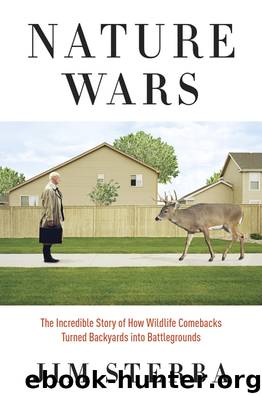Nature Wars by Jim Sterba

Author:Jim Sterba [Sterba, Jim]
Language: eng
Format: epub
ISBN: 978-0-307-98566-8
Publisher: Crown Publishing Group
Published: 2012-11-12T16:00:00+00:00
North American black bears (Ursus americanus) are much smaller than grizzlies and polar bears. They are omnivores and nocturnal for the most part. According to scientists, bears aren’t true hibernators. They wake occasionally in their dens but do not eat or drink for five to seven months starting in late fall. They emerge in the spring hungry and spend most of their time over the next several months looking for food and eating it. They see as well as humans, hear better, and have a very keen sense of smell. About 95 percent of a black bear’s diet is nuts, berries, fruits, roots, and flowers. Like beavers, they peel bark off trees to eat the cambium layers beneath. They eat insects, love the contents of anthills, and raid beehives. Fish, birds, and other mammals are targets of opportunity. Black bears prefer beechnuts and acorns but will eat anything, including fellow bears, if the opportunity presents itself.
The average adult male weighs 250 pounds but can reach 600 or more. Females weigh 160 pounds on average. On their hind legs, black bears can stand four and a half feet to six feet tall. Males become sexually mature at four to six years of age, females at age two to five. Females breed every other year and have litters of two or three rat-sized cubs but may not breed if available food is limited. Cubs stay with their mother and den with her during their first winter, then emerge the following spring as yearlings and are shooed off to find their own territory. Yearlings can travel dozens or even hundreds of miles to find a place to live without competing bears. If they happen into the domain of a territorial adult male, they may be killed. Like other territorial species, bears spread out as their populations grow. How much space a single bear needs depends on how much food is around. An adult male usually needs several square miles of exclusive territory but will roam far beyond to find food. Black bears avoid people, but where people—unthinkingly or on purpose—put out food, bears will eat it, learn to associate the smell of humans with food, and lose their wariness of them—much faster than many people learn to be wary of bears.
By 2002, the World Wildlife Fund reported that black bears had rebounded to an estimated population of between 735,000 and 941,000. Licensed bear hunting was allowed in twenty-seven states, but bear hunting was on the decline. Bear hunters had long been a small minority of hunters: only about 370,000 people bought bear hunting licenses in the United States (compared with more than 10 million deer hunters).19 As old hunters died off, few young people took up the bear hunt.
In addition to promoting the successful 1996 ballot initiative banning “cruel” traps in Massachusetts, the Humane Society of the United States helped fund successful ballot initiatives banning bear baiting, hunting bears with dogs, and using traps on them in Colorado in 1992 and Oregon in 1994.
Download
This site does not store any files on its server. We only index and link to content provided by other sites. Please contact the content providers to delete copyright contents if any and email us, we'll remove relevant links or contents immediately.
The Lonely City by Olivia Laing(4768)
Animal Frequency by Melissa Alvarez(4424)
All Creatures Great and Small by James Herriot(4266)
Walking by Henry David Thoreau(3921)
Exit West by Mohsin Hamid(3791)
Origin Story: A Big History of Everything by David Christian(3665)
COSMOS by Carl Sagan(3584)
How to Read Water: Clues and Patterns from Puddles to the Sea (Natural Navigation) by Tristan Gooley(3430)
Hedgerow by John Wright(3313)
How to Read Nature by Tristan Gooley(3289)
The Inner Life of Animals by Peter Wohlleben(3282)
How to Do Nothing by Jenny Odell(3263)
Project Animal Farm: An Accidental Journey into the Secret World of Farming and the Truth About Our Food by Sonia Faruqi(3188)
Origin Story by David Christian(3169)
Water by Ian Miller(3153)
A Forest Journey by John Perlin(3042)
The Plant Messiah by Carlos Magdalena(2899)
A Wilder Time by William E. Glassley(2832)
Forests: A Very Short Introduction by Jaboury Ghazoul(2814)
